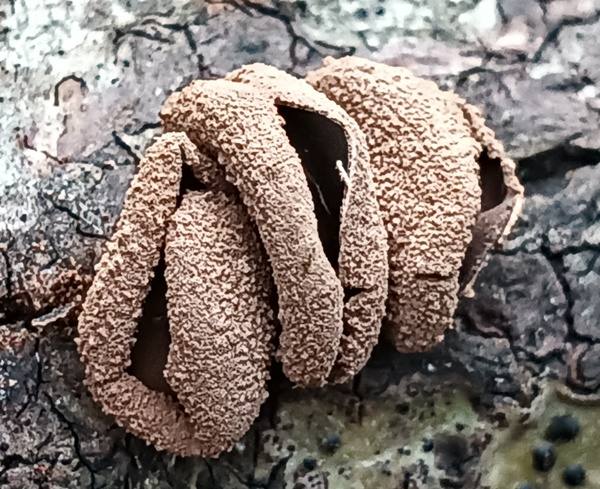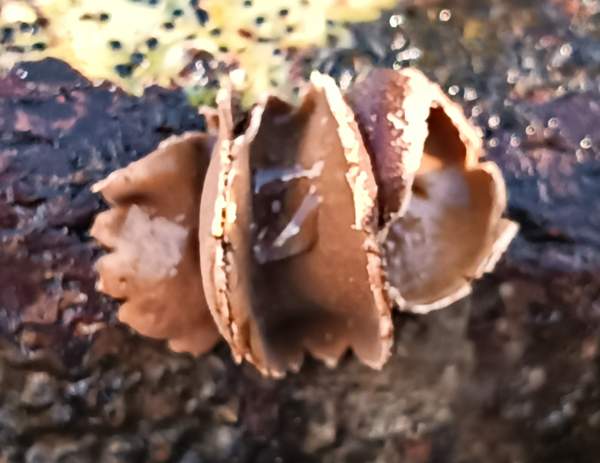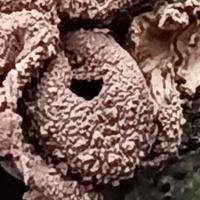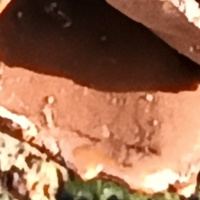Trees Birds Mammals Fish Amphibians Reptiles
Wild Algarve
Bookshop
Encoelia furfuracea (Roth) P. Karst. - Spring Hazelcup
Phylum: Ascomycota - Class: Leotiomycetes - Order: Helotiales - Family: Cenangiaceae
Distribution - Taxonomic History - Etymology - Identification - Culinary Notes - Reference Sources

This uncommon ascomycete fungus appears most often on dead ior dying Hazel stems, and particularly the straightish poles that spring up when Hazel trees and bushes are coppiced. As the common name suggests, fresh apothecia of this cup fungus usually appear just as the first spring bulbs are coming into flower.
Distribution
Encoeliua furfuracea is found throughout Britain and Ireland, where it is most commonly recorded in the south. This ascomycete is also known to occur across much of Europe and Asia as well as North America.

Taxonomic history
This wood-rotting cup fungus was described in 1800 by German botanist Albrecht Wilhelm Roth (1757 - 1834), who gave it the binomial scientific name Peziza furfuracea.It was Finnish mycologist Petter Adolf Karsten who, in 1864, gave this species its currently-accepted scientific name Encoelia furfuracea.
Synonyms of Encoelia furfuracea include Peziza furfuracea Roth, and Dermea furfuracea (Roth) Schwein.
Etymology
The specific epithet furfuracea means 'scurfy' or 'mealy' - a reference to the texture of the infertile outer surface of this cup fungus.
Identification guide
 |
Apothecia
Initially ashallow cup 1 to 5cm across;outer surface scurfy and pale brown; margin initially inrolled; stemless, erupting through the bark either singly or, more often, in small clusters. |
 |
Inner (fertile) surface smooth, orange-brown asci are 8-spored and typically 6 x 95µm. |
| |
Spores
Ellipsoidal, smooth, typically 10 x 2µm.
Spore print
White. |
Odour/taste |
Not distinctive. Like nearly all of the cup fungi, this species in inedible. |
Habitat & Ecological role |
On stems of Hazel and Alder, with one confirmed UK record on Hornbeam. |
Season |
Persisting through the year, with new apothecia appearing from late winter until the end of spring. |
Similar species |
Encoelia fimbriata is similar and occurs generally in larger clusters and nearly always on willows (Salix spp.) but occasionally Prunus species; its asci are tapered cylinders and the ascospores are shorter and much broader than those of E. furfuracea.
There are many cup fungi of various shades of fawn or brown. The key discriminating macroscopic features of Spring Hazelcup are its scurfy light brown outer surface and its substrate - nearly always Hazel. |
Culinary Notes
This cup fungus is not considered edible.
Reference Sources
Dennis, R.W.G. (1981). British Ascomycetes; Lubrecht & Cramer; ISBN: 3768205525.
Breitenbach, J. & Kränzlin, F. (1984). Fungi of Switzerland. Volume 1: Ascomycetes. Verlag Mykologia: Luzern, Switzerland.
Medardi, G. (2006). Ascomiceti d'Italia. Centro Studi Micologici: Trento.
Dictionary of the Fungi; Paul M. Kirk, Paul F. Cannon, David W. Minter and J. A. Stalpers; CABI, 2008
Taxonomic history and synonym information on these pages is drawn from many sources but in particular from the British Mycological Society's GB Checklist of Fungi.
Acknowledgements
This page includes poictures kindly contributed by Donna Rainey.
Top of page...
Fascinated by Fungi. Back by popular demand, Pat O'Reilly's best-selling 450-page hardback book is available now. The latest second edition was republished with a sparkling new cover design in September 2022 by Coch-y-Bonddu Books. Full details and copies are available from the publisher's online bookshop...